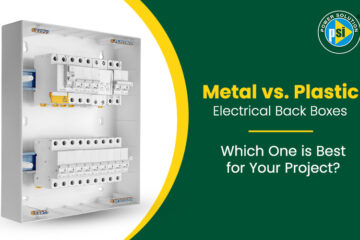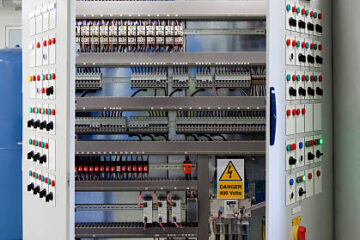When picking out electrical back boxes for your industrial or domestic use, it is better to choose a product that can resist exposure to solids, liquids, or other physical elements. To do that, you need to first consider the solid or liquid hazards that prevail in the area where you will place the electrical back boxes, and then pick a product that meets those specifications.
One useful way to do that is by considering the IP (Ingress Protection) ratings of the electrical back boxes before making the purchase. In simple terms, IP ratings give you an accurate measure of how well such enclosures are protected against impact, dust, moisture, water, and other liquids in any given setting.
This blog covers all the basics of IP ratings for electrical back boxes in detail. With this information, you will find it much easier to get your hands on an electrical back box that fits your space perfectly and lasts for decades. So, let’s get started.
- What is an IP Rating?
- The Importance of IP Ratings
- The Meaning Behind Two Digits in an IP Rating
- First Digit of the IP Rating: Protection from Solid Foreign Objects
- Second Digit of the IP Rating: Protection from Liquids or Moisture
- Third Digit of the IP Rating (Optional): Provides Supplementary Information
What is an IP Rating?
IP stands for ingress protection, and the term IP ratings refers to how well any electrical device, such as an electrical back box, can resist solid or water exposure or ingress. IP codes or ratings are two-digit numbers preceded by the letter IP, which are defined by the International Electrotechnical Commission (IEC) with the international standard IEC 60529 (EN 60529). This code is often followed by an optional letter that gives you an idea about resistance to specific hazards, materials, or testing scenarios.
This rating gives you a very precise account of how well an electrical enclosure can offer protection against dust or moisture, which is much better than vague terms like waterproof or dustproof.
Format
The rating has the format: IPXX. Here, the XX refers to two digits that have a specific purpose. The first digit represents the level of protection against solids, while the second tells you about the level of protection against liquids.
The higher the value of these digits, the better the electrical back box will be in terms of protection against foreign impacts.
If the rating doesn’t have a number and just a simple “X” in its place, it shows that the electrical equipment has not been rated for that specification. So, if, for example, a device has a rating IPX6, it can prevent the ingress of water from powerful jets but can allow the ingress of dust.
Similarly, an enclosure with a rating IP6X means there will be no ingress of dust, but the damage from water or moisture might be a possibility.
The Importance of IP Ratings
To ensure the electrical safety of electrical and mechanical systems and to eliminate hazards for people in industrial and domestic settings, you must consider the IP ratings of every device or enclosure you install in your space.
Using equipment that mentions vague terms like waterproof or dust resistance doesn’t give you a clear idea about the extent of exposure that device can withstand, which puts you at great risk.
An IP rating gives you an idea about
- The resistance to the ingress of moisture or water
- The resistance to the ingress of foreign solid particles and impact
- Resistance to the ingress of users
This rating gives both regular consumers and engineers an accurate idea about the type of enclosure that will fit perfectly in specific indoor and outdoor use cases, which can save time and prevent the purchase of the wrong electrical back boxes that cannot handle the conditions in which they will be used.
You can buy devices with low IP ratings such as IP44, for use in sealed indoor applications, and choose devices with greater IP ratings like IP65 or above for outdoor uses such as in security cameras as they are exposed to water and dust to a greater extent. This is only possible if you first understand the ratings and their purpose.
The Meaning Behind Two Digits in an IP Rating
The two digits of the IP rating help you determine the extent of hazards or certain scenarios that an electrical black box can withstand without breaking. The first digit ranges from 0 to 6, where 0 indicates no protection while 6 indicates maximum protection from solid foreign objects or accidental contacts.
The second digit ranges from 0-8 with an additional 9K digit, which shows the level of protection against water ingress. The following section deals with the detailed description of the IP ratings to give you a better idea.
First Digit of the IP Rating: Protection from Solid Foreign Objects
As mentioned before, the first digit tells you about the level of resistance that an electrical component, like a back box, offers against external elements like dust and impacts from tools or fingers. This number can range from 0 to 6. The following is a detailed account of what each first IP number represents.
| First Digit | Protection Level | Protection Description |
| X or 0 | Not Rated or No Protection | X means there is no data to specify the protection rating, while 0 means no protection. |
| 1 | > 50 mm or 2” | Protection against unintentional impact with large bodies like the back of a hand. No protection against deliberate body contact. |
| 2 | > 12.5 mm or 0.49” | Protection against contact with fingers or similar smaller objects. |
| 3 | > 2.5 mm or 0.098” | Protection against thick wires and tools. |
| 4 | > 1 mm or 0.039” | Protection against invasive tools and insects like wires, slender screws, larger ants, etc. |
| 5 | Dust Protected | Partial Protection against small dust ingress and prevention of harmful deposits. |
| 6 | Dust Tight | Complete protection against dust ingress and contact. A vacuum seal is applied and tested against a continuous flow of air. |
Second Digit of the IP Rating: Protection from Liquids or Moisture
| Second Digit | Protection Level | Protection Description |
| X or 0 | Not Specified or No Protection | X means there is no data to specify protection ratings, and 0 means no protection against water ingress at all. |
| 1 | Vertically Dripping Water | Water dripping vertically will have no harmful impact on the back box. The product is tested for water equivalent to 1 mm (0.039 in) rainfall per minute. |
| 2 | Water Dripping at a 15o tilt | When the device is tilted at an angle of 15 degrees from its normal position and water falls on it vertically, it will cause no harm. Tested for water equivalent to 3 mm (0.12 in) rainfall per minute for 2.5 minutes in different directions. |
| 3 | Water Spraying up to an angle of 60o | Protection against direct water spray at an angle of up to 60 degrees of vertical. |
| 4 | Water Splashing from all Directions | Protection against water splashing from all directions. Tested for 10 minutes with oscillating sprays. |
| 5 | Low-pressure water jets | Protection against water by a 6.3 mm (0.25 in) nozzle from all directions with limited ingress and no harm. |
| 6 | Higher Pressure Powerful Water Jets | Protection against powerful water jets with a 12.55 m or 0.49 inches nozzle from any direction with no harmful effects. |
| 7 | Immersion in water up to 1 meter in depth | No ingress of water when the electrical back box is immersed 1 meter deep for about 30 minutes. |
| 8 | Immersion in water up to more than 1 meter in depth | No water ingress when immersed in water deeper than 1 meter, generally up to 3 meters or 9.8 feet deep. |
| 9K | Hot Water Jets at Very High Pressure | Protection against high pressure, i.e., 8–10 MPa (80–100 bar) and high temperature of about 80 °C water jets such as wash down streams, steam cleaning, etc., at a close range of 10-15cm. |
Third Digit of the IP Rating (Optional): Provides Supplementary Information
Some IP ratings come with an optional letter at the end, which gives you supplementary information about the product.
These letters include,
A: Protection against contact with the back of the hand (>= 50 mm).
B: Protection against impact with a finger (>= 12.5 mm).
C: Protection against access with a tool (>= 2.5 mm).
D: Protection against access with a wire (>= 1 mm).
F: Oil Resistance
G: Oil resistance.
H: High voltage apparatus or device.
M: It shows the device was in motion during the water test.
S: It indicates the device was still during testing.
W: Protection against weather conditions like rain, humidity, etc.
Conclusion
IP ratings are vital for selecting suitable electrical enclosures for wiring and other electrical equipment that can prevent the ingress of solid or liquid elements. The two digits of this rating give you a clear picture of how well an electrical back box is protected against external threats.
You need to consider the IP rating of the electrical back box and compare it with your use case to get the best results. This comparison can save a lot of money in the long run by helping you pick an enclosure that offers maximum resistance to solid and liquid exposure in any given area.
An understanding of IP ratings can help you protect your sensitive equipment, ensure compliance, and guarantee safety. This is why you need to familiarize yourself with this system to avoid wasting your money and eliminate electrical hazards completely.
You can visit us at PSI Power Solutions to explore our premium quality electrical back boxes with high IP ratings for use in oil, gas, utilities, and a wide range of other industries to ensure complete safety and longevity of your electrical systems.

